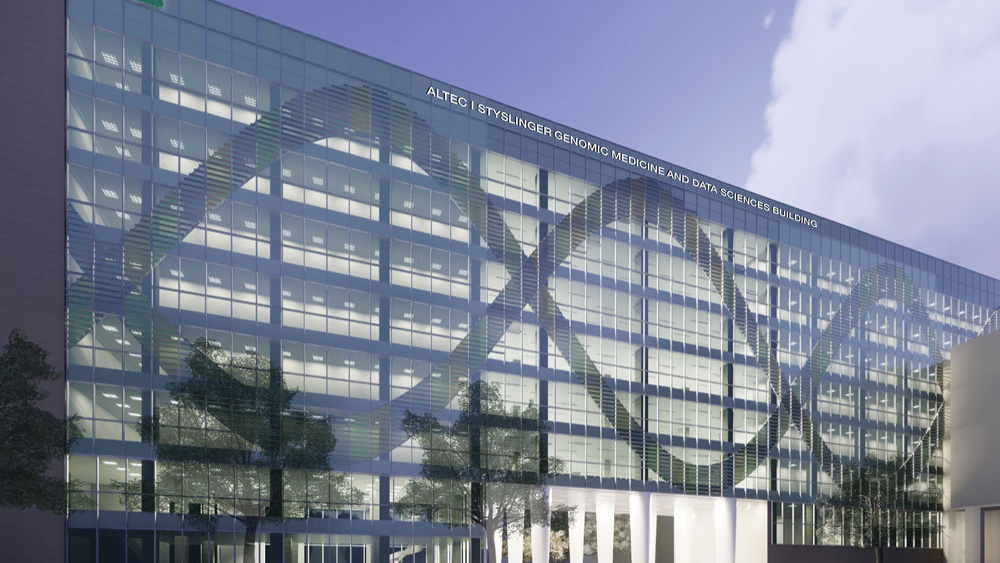 The UAB campus was transformed in 2021 as two buildings—the Pittman Center for Advanced Medical Studies and the Roy R. Kracke Clinical Services Building—were demolished, setting the stage for renovation to begin on the Lyons-Harrison Research Building. Following extensive renovation, Lyons-Harrison will become the Altec/Styslinger Genomic Medicine and Data Sciences Building. The new building will bring together researchers, technology, and staff from UAB’s Hugh Kaul Precision Medicine Institute, Informatics Institute, and Bill L. Harbert Institute for Innovation and Entrepreneurship, as well as translational scientists from many different disciplines, cementing UAB’s place as a genomic and precision medicine research powerhouse.
The UAB campus was transformed in 2021 as two buildings—the Pittman Center for Advanced Medical Studies and the Roy R. Kracke Clinical Services Building—were demolished, setting the stage for renovation to begin on the Lyons-Harrison Research Building. Following extensive renovation, Lyons-Harrison will become the Altec/Styslinger Genomic Medicine and Data Sciences Building. The new building will bring together researchers, technology, and staff from UAB’s Hugh Kaul Precision Medicine Institute, Informatics Institute, and Bill L. Harbert Institute for Innovation and Entrepreneurship, as well as translational scientists from many different disciplines, cementing UAB’s place as a genomic and precision medicine research powerhouse.
The Pittman Center for Advanced Medical Studies was built in the late 1970s and opened its doors in 1980. The idea for the center was fostered by Tinsley Harrison, M.D., second dean of the four-year Medical College of Alabama (the School of Medicine’s predecessor institution) and longtime chair of the Department of Medicine. The building was named for James Pittman Jr., M.D., the School of Medicine’s longest serving dean (1973-1992). Over the course of its storied history, the building’s living quarters hosted many renowned visiting scholars, including Anthony Fauci, M.D., director of the National Institute of Allergy and Infectious Disease; Linus Pauling, Ph.D., two-time Nobel Prize winner for his research into chemical bonding and his peace activism; Nobel Prize winner Peter Agre, who discovered water channels in cell membranes; Former Secretary of State Henry Kissinger; and James Watson, Ph.D., and Francis Crick, Ph.D., who won the Nobel Prize for their discovery of the double helix structure of DNA.
The Roy R. Kracke Clinical Services Building was built in 1929 as a dormitory for nurses of Hillman Hospital and nursing school students, a purpose it served for over 30 years. In 1965, the building was dedicated to Roy R. Kracke, M.D., first dean of the four-year Medical College of Alabama (1944-1950). Along with the dedication came a number of renovations to the building, including modernized work areas, new equipment for clinical laboratories and surgical pathology, and the first Cores laboratory. A faculty dining room and lounge provided the first on-campus haven and rest area for physicians.
The Altec/Styslinger Genomic Medicine and Data Sciences Building will provide modernized space for enhanced collaboration and cutting-edge research. It was made possible by a generous gift from the Altec/Styslinger Foundation and funding commitments from Jefferson County and the state of Alabama. The completion of the building—projected for fall 2023—will allow for the recruitment of approximately 50 new principal investigators specializing in genomic and precision medicine, as well as approximately 350 new research and health care jobs. Additionally, the new space will generate more funding from the National Institutes of Health and other private and public sources.
The building’s most important benefit, however, is its potential for improving the health of the people of Alabama and beyond. “Genomic approaches have provided powerful tools to diagnose—and recently even to treat—rare disorders due to changes in individual genes,” says Associate Dean for Genomic Medicine Bruce Korf, M.D., Ph.D., the Wayne H. and Sara Crews Finley Endowed Chair of Medical Genetics and chief genomics officer for UAB Medicine. “We are now able to extend this analysis to understand the genomic underpinnings of common disorders such as diabetes and heart disease. The promise of this building, and of the work that will take place within it, is to employ genomics to bring new knowledge of disease risk, and new strategies for prevention and treatment of both rare and common diseases.” – Mary Ashley Canevaro, Bob Shepard
